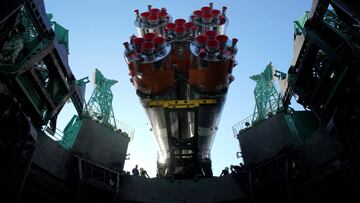Why is Russia launching a new mission to space?
Since December, three members of the International Space Station have been stranded on the orbiting platform after their ride home sprung a coolant leak.

Russia is sending an unmanned Soyuz capsule to the International Space Station to replace another that experienced a coolant leak in December. The incident, which was determined to have been caused by a micrometeoroid strike, left three members of the ISS crew without a designated ride home.
Russia’s space agency Roscosmos had announced that it would wait until March to send the replacement spacecraft after another capsule docked at the ISS developed a leak of its own 11 February. However, after completing its investigation into the leak of the Soyuz MS-22 and the Progress-82 freighter spacecraft it was deemed safe to send the alternate ride home for the two cosmonauts and one US astronaut.
The Soyuz MS-23 spacecraft will launch from the Russia-run Baikonur Cosmodrome in Kazakhstan Thursday 24 February at 7:24 pm EST (Friday 23 February at 3:34 am local time). The launch can be viewed live on NASA Television via YouTube.
Leaks from second spacecraft docked at ISS delays replacement Soyuz
The three members of the ISS with no sure ride home until the Soyuz MS-23 arrives include NASA astronaut Frank Rubio and Roscosmos cosmonauts Sergey Prokopyev and Dmitri Petelin. They arrived at the space station in September joining Expedition 67 and were due to stay aboard for six months. Their tour in space was set to end in late March returning to Earth on Soyuz MS-22.
However, 14 December just prior to a planned spacewalk by Prokopyev and Petelin a leak was detected by multiple pressure sensors in the module’s cooling loop. The spacewalk was postponed while the situation could be evaluated. Cameras captured a spray of white particles venting from Soyuz MS-22. It was later determined that it was coolant, and it was determined that the spacecraft would be unfit for a return manned flight, except in an emergency, due to possibly overheating.
Roscosmos planned to move up the launch of Soyuz MS-23 to replace the damaged spacecraft but a little over a week prior to its launch a cargo ship docked at the ISS sprung its own leak. That forced the delay of the relief Soyuz until March until investigations could be carried out.
Russia determined that it was safe to launch new space mission
The Progress-82 freighter managed to undock successfully and as it left last week captured images of the damaged Soyuz. The footage allowed the Russian space agency to determine that the two incidents were the result of unrelated micrometeoroid strikes.
With that information, Roscosmos chose to reschedule the Soyuz MS-23 launch once again for later this week. The spacecraft will travel for two days before it docks with the ISS.






